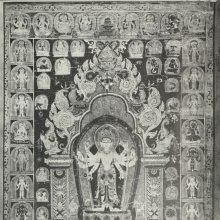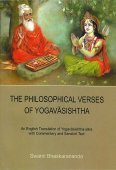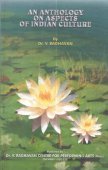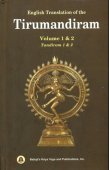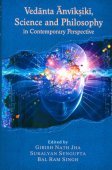Ramakrishna, Rāmakṛṣṇa: 7 definitions
Introduction:
Ramakrishna means something in Hinduism, Sanskrit, Jainism, Prakrit. If you want to know the exact meaning, history, etymology or English translation of this term then check out the descriptions on this page. Add your comment or reference to a book if you want to contribute to this summary article.
Ramakrishna has 5 English definitions available.
The Sanskrit term Rāmakṛṣṇa can be transliterated into English as Ramakrsna or Ramakrishna, using the IAST transliteration scheme (?).
Images (photo gallery)
Languages of India and abroad
Sanskrit dictionary
[Deutsch Wörterbuch]
Source: Cologne Digital Sanskrit Dictionaries: Böhtlingk and Roth Grosses Petersburger WörterbuchRāmakṛṣṇa (रामकृष्ण):—m. Nomen proprium verschiedener Männer [Colebrooke] [?I,230. 234. II,453. Weber’s Indische Studien.1,27. 59.3,250. Weber’s Verzeichniss No. 166. 267. 330. 630. 673. 965. 1019. Oxforder Handschriften 141,a,20. 223,a, No. 541. fg. 277,a, No. 654. 289,b, No. 694. 291,a, No. 705. 321,b, No. 763. 394,a, No. 103. HALL 25. 27. 98. 181.] tīrtha [Bibliothecae sanskritae 421. fg.] dīkṣita [HALL 100.] [Colebrooke I, 336.] deva [II, 454.] paṇḍita [HALL 105.] bhaṭṭa [173. fgg. 181. 183.] [Weber’s Verzeichniss No. 140. 966. 1223.] bhaṭṭācārya [HALL 8.] bhaṭṭācāryacakravartin [66.] rāya [KṢITĪŚ. 33, 5. 45, 1.] rāmakṛṣṇācārya [Weber’s Verzeichniss No. 540.] rāmakṛṣṇādhvarin [HALL 100.] rāmakṛṣṇānandatīrtha [136. 189.]
Source: Cologne Digital Sanskrit Dictionaries: Sanskrit-Wörterbuch in kürzerer FassungRāmakṛṣṇa (रामकृष्ण):—m. Nomen proprium verschiedener Männer. Auch tīrtha , dīkṣita , deva , paṇḍita , bhaṭṭa , bhāṭṭācārya , bhāṭṭācāyacakravartin , rāya , kṛṣṇācārya , kṛṣṇādhva rin und kṛṣṇānandatīrtha.
Sanskrit, also spelled संस्कृतम् (saṃskṛtam), is an ancient language of India commonly seen as the grandmother of the Indo-European language family (even English!). Closely allied with Prakrit and Pali, Sanskrit is more exhaustive in both grammar and terms and has the most extensive collection of literature in the world, greatly surpassing its sister-languages Greek and Latin.
See also (Relevant definitions)
Partial matches: Krishna, Rama.
Starts with (+11): Ramakrishna acarya, Ramakrishna bhatta, Ramakrishna bhattacarya, Ramakrishna bhattacarya cakravartin, Ramakrishna daivajna, Ramakrishna dikshita, Ramakrishna dikshita nahnabhai, Ramakrishna kadamba, Ramakrishna kavi, Ramakrishna mishra, Ramakrishna pandita, Ramakrishna sharman, Ramakrishna suri, Ramakrishna tarkapancanana, Ramakrishna vaidyaraja, Ramakrishna yajvan, Ramakrishnabhatta, Ramakrishnabhattacarya, Ramakrishnabhyudaya, Ramakrishnadeva.
Ends with: Bhatta ramakrishna, Bhava ramakrishna, Bhavaramakrishna, Kadamba ramakrishna, Shesha ramakrishna.
Full-text (+325): Ramakrishnadikshitiya, Shabdabodhaprakriya, Nahnabhai, Siddhantakaumudivadartha, Vaiyakaranasiddhantaratnakara, Ramakrishniya, Chandogahnikapaddhati, Panditashiromani, Ramakrishnakavya, Ramakrishnapaddhati, Ramakrishnasamvada, Ramakrishnastotra, Ramakrishnadeva, Dashavtar, Ramakrishnavilomakavya, Shabdaprakriya, Bhavaramakrishna, Maniramakrishnadikshitiya, Ramakrishnanandatirtha, Ramakrishna dikshita.
Relevant text
Search found 89 books and stories containing Ramakrishna, Rāmakṛṣṇa, Ramakrsna, Rama-krishna, Rāma-kṛṣṇa, Rama-krsna; (plurals include: Ramakrishnas, Rāmakṛṣṇas, Ramakrsnas, krishnas, kṛṣṇas, krsnas). You can also click to the full overview containing English textual excerpts. Below are direct links for the most relevant articles:
Sri Rama Krishna Jnana and Vijnana < [Jan. – Mar. 1991 & Apr. – Jun. 1991]
Three Eminent Andhra Educationists < [October-December 1942]
Ramakrishna’s Message for the Modern Age < [January – March, 1987]
Preceptors of Advaita (by T. M. P. Mahadevan)
Social philosophy of Swami Vivekananda (by Baruah Debajit)
Chapter 1.0 - Introduction (Swami Vivekananda’s life and history)
Chapter 1.1 - Influences that Shaped Swami Vivekananda’s Philosophy
Amarakoshodghatana of Kshirasvamin (study) (by A. Yamuna Devi)
Commentaries on Amarakośa < [Chapter 1 - Kośa Literature–A Brief Survey]
Need for the present study < [Chapter 1 - Kośa Literature–A Brief Survey]
Amaravati Art in the Context of Andhra Archaeology (by Sreyashi Ray chowdhuri)
The flourishing agriculture and prosperity in Amarāvatī (Dhānyakaṭaka) < [Chapter 4 - Survival of Amarāvatī in the Context of Andhra Art]
Region Beyond The Coastal Lines (7): Koṭaliṅgala < [Chapter 2 - Amarāvatī and other Archaeological Sites of Ancient Andhra Pradesh]
Region Beyond The Coastal Lines (8): Satanikoṭa < [Chapter 2 - Amarāvatī and other Archaeological Sites of Ancient Andhra Pradesh]
Jainism and Patanjali Yoga (Comparative Study) (by Deepak bagadia)
Part 4.6 - Methods of Purification of Mind (citta-prasadana) < [Chapter 2 - Yoga philosophy and practices]
Part 4.4 - Yogic techniques for control of Vrttis (5): Isvara-pranidhana < [Chapter 2 - Yoga philosophy and practices]
Part 4.7.1 - Klesas (Afflictions) < [Chapter 2 - Yoga philosophy and practices]
Related products
(+3 more products available)
